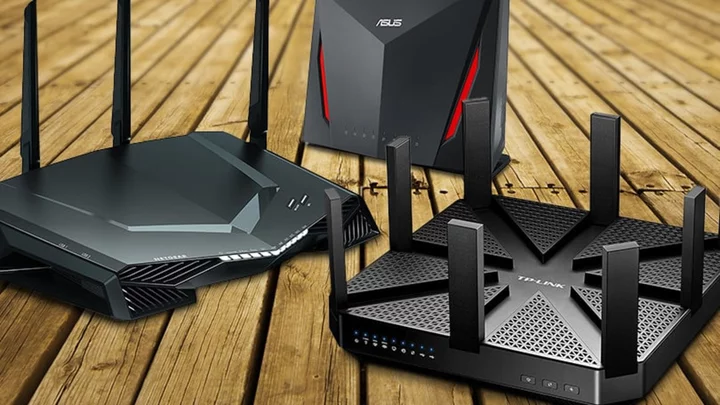If you're a PC-gaming enthusiast, you know about speed. Gaming rigs are good only if they're tricked out with the latest and fastest CPUs, lots of memory, the quickest solid state drive (SSD), and, of course, the best graphics cards. But while that combination will definitely give you a fast machine, online gaming performance can still be hampered if it's connected to a crowded network with an internet connection controlled by an overburdened or old-fashioned wireless router. Plus, home networks are more taxed than ever, now that so many folks are working from home. So if game performance is important to you, it's well worth your time to take a close look at optimizing your network.
Start with what's connected. A whole family's worth of gear can mean oodles of phones, tablets, TVs, streaming video/music devices, and smart home gear all connecting to—and hammering—the beleaguered household router. (It's not an exaggeration that some households will have dozens of devices.) Any online gamers in the house must compete for that router's bandwidth with not only everyone else but also all those smart devices. And that can lead to unpredictable, often subpar, performance.
Now, on a basic level, many routers, even those we classify as budget routers, offer Quality of Service (QoS) settings that let you give priority to devices or applications that require lots of bandwidth. But not many of them offer the gamer-centric settings and optimizations that you get with a dedicated gaming router. If network lag is messing with your game, read on to find out which gaming routers we recommend. After the list of top picks, we'll go into more detail about how to choose the one that best suits your household, your play style, and your budget.
Gaming Router vs. Regular Router: What's the Difference?
Perhaps the biggest difference between a gaming router and a typical consumer router is how it handles QoS, or bandwidth prioritization duties. Almost all routers offer some sort of QoS. This can be as basic as the generic Wi-Fi Multimedia (WMM) extensions that automatically prioritize network packets carrying data necessary for voice over IP (VoIP) and video conferencing apps. Or the QoS can be as granular as drag-and-drop prioritization that lets you assign a higher priority to specific devices connected to the network, essentially making sure they experience better performance than other devices.
Gaming routers go a step further, by offering prioritization for specific gaming systems and applications, and allowing you to decide how much bandwidth each client is entitled to. That can be especially important if you have multiple online gamers in the same household, who are all competing for the feed from the same pipe. For example, Linksys gaming routers have firmware that automatically gives network priority to devices that are equipped with the Intel Killer Prioritization Engine. When the router detects a device equipped with Killer networking hardware, it gives that device the lion's share of bandwidth to ensure smooth, lag-free online gameplay.
Many gaming routers also use a modified management console with a gamer-friendly user interface that makes it easy to assign bandwidth priorities on the fly. Netgear recently began outfitting its gaming routers with DumaOS, an interactive, gamer-friendly operating system developed by Netduma. It has a sleek-looking dashboard that lets you see what is going on with your network at a glance, with graphs showing real-time CPU and bandwidth usage, currently installed apps, guest networking status, Wi-Fi status, and internet status.
It also has a Geo-Filter feature that can help reduce lag by limiting the distance to the host servers you play on. By setting your home location on the map and specifying a distance range, you can prevent players and servers that are outside of your range from hosting your game.
You can also use customized software to enhance online gaming performance. Using firmware from sources such as OpenWRT, DD-WRT, and Tomato, you can unleash the full potential of your router to enhance overall signal strength, monitor real-time usage, and prioritize bandwidth usage. To do this, though, the router must support open-source firmware upgrades. Make sure you have a good idea of how routers and firmware work together before you decide to go this route.
Dual-Band or Tri-Band: What's Best for Gaming?
Any gaming router worth its salt will offer at least two radio bands. The 2.4GHz band is the most widely used band and tends to get more crowded than the 5GHz one. You'll get much better range on the 2.4GHz band, but it can't match the speeds that you get with the 5GHz. Every router that comes through PC Labs is thoroughly tested across all bands, but you should be aware that different bands can have an impact on performance.
If your gaming system is in close proximity to your router, the 5GHz band will provide the best throughput performance. If you have numerous devices connecting to your network, a tri-band router is your best bet, especially if you're also employing range extenders to reach the far corners of your home. Tri-band routers add a second 5GHz band that you can dedicate to certain devices or applications. For example, you can reserve an entire 5GHz band just for gaming (so long as your PC-gaming rig or your console supports 5GHz Wi-Fi) and use the other 5GHz band for high-bandwidth applications such as video streaming, massive file transfers, or torrent downloads. This leaves the more crowded 2.4GHz band free for everyday tasks such as web surfing and connecting to smart-home devices such as lights, cameras, locks, and security systems.
Buying for Tomorrow: MU-MIMO, Beamforming, and Wider Channels
Of course, if you are a dedicated online gamer (or you have one in your household), you know that network demands for the latest games seldom move in the direction of "less demanding." So you'll want to make sure you choose a future-proof router.
Multi-User Multiple Input Multiple Output (MU-MIMO) technology is a big feature to look for today. It allows for simultaneous data streaming to multiple clients, as opposed to sequential streaming. This is a very handy feature; the main caveat is that each client device has to support MU-MIMO to take advantage of the improved throughput. As new gear gets added to your network in coming years, however, it's more and more likely to support MU-MIMO, so you'll be glad you opted for it in your router. (For more on MU-MIMO, check out our primer, Understanding MU-MIMO Wireless.)
Another key emerging tech to look for, beamforming, also helps to improve throughput. As the name suggests, it involves shaping the signal itself, in the interest of efficiency and increasing range. It transmits a Wi-Fi signal in a more focused manner straight at a client, rather than broadcasting in all directions. To gain the benefit, both devices need to support beamforming tech, so that each can communicate its relative position to the other, and thus focus the signal in the proper direction.
Be aware that, while all Wi-Fi 6 (802.11ax) devices (more about which in a moment) support beamforming, not all 802.11ac routers do. (Also, know that some router makers refer to the beamforming feature in their products with their own proprietary names.)
Many of the latest routers also offer a wider channel bandwidth of up to 160MHz, compared with the typical 40MHz and 80MHz channel widths that you get with older routers. As with MU-MIMO, you'll need 160MHz-compatible clients to access the wider channels. But it makes wholehearted sense to opt for 160MHz in a new gaming router now, seeing as, like with MU-MIMO, support for it will become increasingly common in new devices you add to your network down the road.
What Is Wi-Fi 6?
802.11ax is also known Wi-Fi 6 or High Efficiency (HE) Wireless, and there is no shortage of Wi-Fi 6 routers on the market. This standard is an evolution of 802.11ac technology. It promises increased throughput speeds (up to 4.8Gbps), less network congestion, greater client capacity, and better range performance courtesy of several new and improved wireless technologies including Orthogonal Frequency-Division Multiple Access (OFDMA) and Target Wake Time (TWT). OFDMA improves overall throughput by breaking Wi-Fi channels into sub-channels, allowing up to 30 users to share a channel at the same time. Target Wake Time (TWT) is designed to reduce power consumption by allowing devices to determine when and how often they will wake up to begin sending and receiving data. TWT tech is expected to extend the battery life of mobile devices such as smartphones and tablets, as well as battery-powered smart home devices such as security cameras and video doorbells.
All these capabilities make Wi-Fi 6 perfect for Wi-Fi mesh networks, which are fast becoming the most popular choice for broad home networking, even more so now that they're starting to drop in price.
The Best Wireless Routers for 2022Aside from its suitability as a mesh protocol, 802.11ax takes advantage of previously unused radio frequencies to provide faster 2.4GHz performance, and it uses refined uplink and downlink bandwidth management to provide enhanced QoS. It also offers uplink and downlink MU-MIMO streaming. (In contrast, 802.11ac supports only downlink MU-MIMO.) As with the 802.11ac protocol, 802.11ax is backward-compatible and works with devices that use 802.11a/b/g/n/ac Wi-Fi radios. Although 802.11ax routers are widely available, there are still many client devices that don’t yet support this latest standard. If you're thinking about upgrading now, read our explainer first.
Some gaming-specific routers now also support the latest Wi-Fi standard, Wi-Fi 6E. This spec is the same as Wi-Fi 6, as far as software and features go, but routers that support 6E can access the newly released 6GHz band. That provides a huge bandwidth boost, so it helps with bandwidth-hungry apps, especially games, as well as chronic connection problems due to congestion in more crowded environments, like an apartment building. However, your Wi-Fi 6E-enabled gaming device must be located in the same room (or very nearby) to connect to a Wi-Fi 6E router using the 6GHz band, as 6GHz signal range is much shorter than 2.4GHz range.
More to Know: Ports, Security, Access Controls
Most gaming routers use the same hardware inside that traditional Wi-Fi routers do, but you'll often be able to tell the gaming models apart from the rest on sight. They usually sport a somewhat different exterior-chassis design than their general-purpose counterparts. Shop around, and you may see unusual flair, such as a stylish enclosure or even LED illumination effects.
On a more utilitarian level, look for a router that has at least four gigabit LAN ports, so you can offer up wired connectivity to nearby gaming consoles, printers, and PCs. At least one USB port, preferably supporting USB 3.0, comes in handy for attaching peripherals you want to share across the network, such as portable hard drives, flash drives, and printers. A router with two such USB ports offers a lot more flexibility.
Parental controls are important, too, especially if you happen to have younger children. They allow you to block access to certain sites (think: adult content), limit online gaming or overall network access to specific hours and days of the week, and monitor network usage for each client. A guest-networking feature is also worth looking for if you often have digitally savvy houseguests, as it lets you provide limited wireless access to your network using a separate SSID and password. This way, your guests can access the internet, but they can't see other network assets, such as folders, files, printers, and the identities of other connected clients. (Plus, you can assign guests to a radio band that won't interfere with your gaming!)
All routers, of course, offer some type of security. Wi-Fi Protected Access (in WPA and/or WPA2 flavors) is the most common, and it requires that each client use a password to access the network. Support for Wi-Fi Protected Setup (WPS) is also common and very convenient, as it allows you to add WPS-compatible clients to your network with the push of a button. For more robust security measures, though, look for a router that supports WPS-Enterprise or Remote Authentication Dial-In User Service (RADIUS) authentication.
So, What Is the Best Gaming Router to Buy?
You'll find a rundown of our favorite gaming routers' specs below. Once you've found the right model for your home and budget, you'll also want to see our tips for setting up your router and boosting your Wi-Fi signal.









